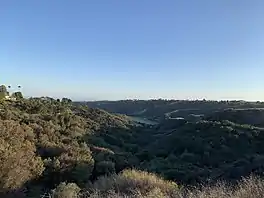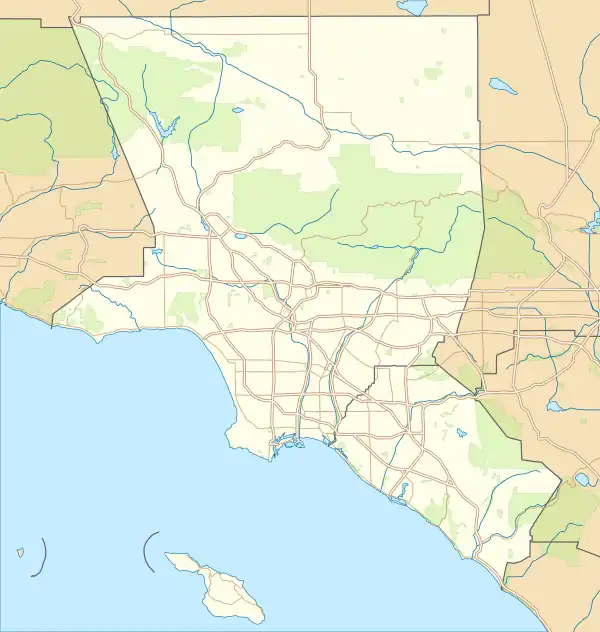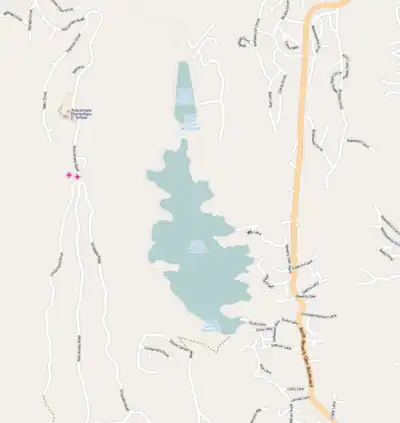Stone Canyon Reservoir
Stone Canyon Reservoir and Upper Stone Canyon Reservoir are adjoining reservoirs in the Westside region of Los Angeles, California. Situated in the Santa Monica Mountains at 847 feet (258 m) above sea level, the reservoirs lie in the Bel Air neighborhood, south of Mulholland Drive and west of North Beverly Glen Boulevard. The main reservoir is the Stone Canyon Reservoir with the much smaller, cone-shaped Upper Stone Canyon Reservoir adjoining it to the north. The two reservoirs supply the Westside water subsystem,[1] including service to around 400,000 people in Pacific Palisades, the Santa Monica Mountains, and West Los Angeles.
| Stone Canyon Reservoir | |
|---|---|
 The Reservoir as seen from the Stone Canyon Overlook off of Mulholland Drive. | |
 Stone Canyon Reservoir  Stone Canyon Reservoir  Stone Canyon Reservoir | |
| Coordinates | 34°6′40″N 118°27′16″W |
| Built | 1952 |
| Surface elevation | 843 feet (257 m) |
| Settlements | Bel Air, Los Angeles, California, USA |


History
The reservoirs are owned by the Los Angeles Department of Water and Power. The main reservoir, which is the lower reservoir and the larger of the two, is situated south of the upper reservoir. It was designed and built in 1924 by the Los Angeles Department of Water and Power's water branch, the Bureau of Water Works and Supply (BWWS).[2] As with most other BWWS reservoirs of the time, it is of earth fill construction which was placed utilizing the hydraulic sluicing method. This method was pioneered and refined by William Mulholland. This reservoir had an original capacity of 8,000 acre⋅ft (9,900,000 m3).[2]
In the mid 1950s, the upstream part of the dam was rebuilt as a roller compacted backfill founded on rock, while the downstream part remained unchanged. The rehabilitation work was completed in 1956. The 160 feet (49 m) high dam was examined from the safety considerations to withstand seismic factors. Seismic studies were carried out in 2002 and the conclusion was that the Lower Stone Canyon Dam could be "operated safely with the reservoir level at its design elevation of 865 feet (264 m)."[3]
Project features
Stone Canyon Reservoir is composed of two reservoirs, namely, the larger Lower at 34°6′24″N 118°27′09″W and the Upper at 34°07′06″N 118°27′21″W. The elevation of the Lower is 243 feet (74 m) at full reservoir level and 247 feet (75 m) at maximum water level.[4][5] When built, both reservoirs stored treated drinking water. This enabled surface runoff to flow into the reservoir. resulting in contamination.[6]
The Lower Reservoir is in an irregular shape with a shore line of 5,500 feet (1,700 m) and surface area of 117 acres (47 ha). The 70 ton water treatment plant commissioned in January 1952 is located downstream. The intake was designed as an inclined tower to maximize the natural site conditions which enabled the design of the tower to be based on the unit weight factor.[7]
It was established in 1952 for a total of around $9 million.[8] Construction was partly funded by the California Department of Transportation Environmental Enhancement and Mitigation Grant Program.[9] Taking advantage of the natural terrain, an inclined tower was built that eliminated the need for an access bridge and reduced the unit bearing load.[10] A somewhat unusual change in radon level began at the canyon in 1984, possibly a result of a reservoir level change.[11]
At least part of the lower reservoir expansion included asphalt linings.[12] Some of the landslides at the upper reservoir were caused by undercut grading. To compact the area brush and reduce the height of the flammable materials, heavy drums were filled with water and then rolled up and down the slopes. Proposed 2004 system changes included removing the reservoir from normal operating service, and retaining it for emergency storage only.[13]
However, as the reservoirs were of open surface type, in later years, they did not conform to the prescribed water quality standards for potable water. The Federal and State Surface Water Treatment Rules prescribed that covering of all smaller reservoirs and building of filtration plants at all large ones was essential. The authorities connected with the Lower Stone Reservoir were directed by the Department to build a filtration plant facility below the dam, in a 13 acres (5.3 ha) area within 100 feet (30 m) of Stone Canyon Road residences.[14]
In the studies conducted in 1991 on the quality of the water stored in the two surface reservoirs it was concluded that the water stored had high turbidity values (about 1 NTU which was more than the standard acceptable value of 0.5 NTU) as it received surface water inflows from the catchment of the reservoir. It was also noted that the coliform bacteria level was also higher than the upper reservoir. High algae count was also reported during the summer season. Further, the average THM value measured was a high of 24 µg/L. These aspects of deteriorating water quality of the two surface reservoirs necessitated provision of water treatment plant (filtration plant).[15]
However, following the Federal and State Government directives, a 20,000 square feet (1,900 m2) membrane filtration and pumping facility was built at an estimated cost of $65 to 70 million to supply 6.5 million US gallons (25,000 m3) of water per day to serve 400,000 customers. A security fence was also built around the facility.[14]
Decommissioning of Lower Stone Canyon Reservoir
Planning for further improvement in treatment and supply facility was undertaken in 2004. This was to ensure removal of potential contaminants from the Lower Stone Canyon Reservoir water. This was proposed to conform to the safe drinking water standards through a microfiltration plant that would treat the surface water through membrane filtration along with chemical disinfection before it entered the distribution system. This new plant also provided for fully automated remote operation. This plant was located in a valley on the left abutment of Lower Stone Canyon Dam near the existing reservoir outlet. All visible elements were Architectural aesthetics ensured adoption of existing trees with its precincts and acoustics of operation ensuring an ambient noise level of not more than 30 decibels.[6] The project titled “The Stone Canyon Water Quality Improvement Project” was undertaken by the Los Angeles Department of Water and Power with allocation of $75 million. The project construction was started in 2004 and completed by the end of 2007. Along with this project, the Los Angeles Department of Water and Power also undertook an upgrade of the security and safety of the city's water system at a cost of $132 million spent over a five-year period. This security initiative was an outcome of the terrorist attacks of 9/11.[16]
After the upgrade of the water treatment and supply facility, the Lower Stone Reservoir is not in use except in emergency situations. The unique feature of this project is that a 63 inches diameter bypass HDPE pipeline is laid over a length of 8,000 feet (2,400 m). Half of this length is submerged below the surface of the lower reservoir bypassing it from where the treated water is directly supplied to the customers from the Los Angeles Aqueduct Filtration Plant in Sylmar.[17]
The lower reservoir has a capacity of 3.38 billion US gallons (12,800,000 m3) of water while the upper reservoir has capacity to store 138 million US gallons (520,000 m3) of water. However, the upper reservoir has been built with sufficient safeguards against surface runoff by way of boundary channels which is not the case in the lower reservoir. Moreover, the Lower Stone Canyon reservoir no longer supplies customers directly.[17]
The reservoirs are subject to flash floods, when they are put out of service during the period of the flood.[7] In case of 100 year storm rainfall, the Upper Stone Canyon Reservoir spills to the lower reservoir where it is taken through the filtration process before supplying to the customers.[17]
Decommissioning of the Upper Stone Canyon Reservoir
A proposal to replace the existing Upper Stone Canyon Reservoir is under active consideration. The proposal is to replace the surface reservoir with three underground reservoirs beneath it to store 81 million US gallons (310,000 m3) of water. The underground structures are proposed to be covered initially with soil and then covered over with local vegetation. Hiking trails are also proposed to pass through the filled up area as a recreational activity to trek the canyon. The objective of this project is basically to follow the regulations set under the Federal Laws for uncovered reservoirs. The lower reservoir has already been decommissioned for regular use but with provision to address emergency situations with a small water treatment plant built to handle such a situation. In case of fire emergency it is planned that the lower reservoir which has enough storage could provide firefighting requirements. The security aspect is also suitable addressed with the project of transferring water under the Stone Canyon Water Quality Improvement Project. Last reported in 2009, the Environment Impact assessment study of this project was under way with the Board of Water and Power Commissioners entailed to take a decision regarding the proposed project.[18]
In fiction
The reservoir has been used as a setting in movies and novels. In 1974, the reservoir was used as a location for the movie Chinatown.[19] Page one of the first galley proofs of Irving Wallace's 1974 novel The Fan Club is set overlooking Stone Canyon Reservoir.[20] Page two of Sunset Express, a 1996 detective novel by Robert Crais, is set by the reservoir.[21]
Overlook
The 55-mile-long Mulholland Scenic Parkway and Corridor is one of the most famous thoroughfares in the US and includes the 24 miles (39 km) of Mulholland Drive, which passes through the City of Los Angeles. This drive was constructed in 1924 with the objective of providing a scenic panorama of the mountains, beaches and reservoirs along its winding route. In 1994, the Stone Canyon Reservoir Overlook was developed on the south side of Mulholland Drive. Funds for this facility were provided by the California Department of Transportation Environmental Enhancement and Mitigation Grant Program.[22]
Recreation
Stone Canyon Reservoir is closed to the public. There is no fishing, sailing, or swimming.
Notable residents
The 1959 Henry Singleton house,[23] the 1972 Wilt Chamberlain house,[24] and Della Reese's house overlook the reservoir.[25]
See also
References
- Wang, Yu (January 2006). Seismic performance evaluation of water supply systems. Cornell University. p. 99.
- 23rd Annual Report of the Board of Public Service Commissioners, Report of the Chief Engineer
- "Evaluating The Seismic Performance of Stone Canyon Dam With 2-D And 3-D Analyses" (PDF). 13th World Conference on Earthquake Engineering. August 1–6, 2004. Retrieved 22 February 2011.
- "Stone Canyon Reservoir". Geographic Names Information System. United States Geological Survey, United States Department of the Interior. Retrieved Jan 16, 2021.
- "Stone Canyon Reservoir Fishing in Los Angeles County, California:Beverly Hills Area". Fishingworks.com. Retrieved 22 February 2011.
- "Black & Veatch Announces Groundbreaking For Stone Canyon Pumping And Filtration Plant". waterindustry.org. Retrieved 23 February 2011.
- American Society of Civil Engineers (1953). Proceedings of the American Society of Civil Engineers. The Society. Retrieved 24 February 2011.
- Engineering news-record. McGraw-Hill Pub. Co. January 1954. Retrieved 20 February 2011.
- "Stone Canyon Overlook". LA Mountains. Retrieved 20 February 2011.
- "Water works engineering". 115. New York City. 1962.
{{cite journal}}: Cite journal requires|journal=(help) - Jacobson, Muriel L, ed. (1984). "Summaries of technical reports". 18. U.S. Geological Survey: 328.
{{cite journal}}: Cite journal requires|journal=(help) - Western construction news. Vol. 31. King Publication. 1956. p. 60.
- Taylor, Craig E.; Vanmarcke, Erik (2006). Infrastructure risk management processes: natural, accidental, and deliberate hazards. ASCE Publications. pp. 246, 254–255. ISBN 978-0-7844-0815-5. Retrieved 23 February 2011.
- "Stone Canyon Reservoir: Water Quality Improvement Plan". Bel~Air Online: The Official Bel~Air Association Website. Retrieved 22 February 2011.
- Uncovered finished water reservoirs guidance manual. DIANE Publishing. 1999. pp. 6–. ISBN 978-1-4289-0306-7. Retrieved 24 February 2011.
- "Upgrades in the Canyon". Waterefficency.net. Retrieved 22 February 2011.
- "Upgrades in the Canyon". Waterefficency.net. Retrieved 22 February 2011.
- "Upper Stone Canyon Reservoir Project: Q&A's" (PDF). Savestonecanyonreservoir.org. Retrieved 23 February 2011.
- Medved, Harry; Akiyama, Bruce (27 June 2006). Hollywood Escapes: The Moviegoer's Guide to Exploring Southern California's Great Outdoors. Macmillan. pp. 256–. ISBN 978-0-312-30856-8. Retrieved 23 February 2011.
- Leverence, John; Grogg, Sam L. (1974). Irving Wallace: a writer's profile. Popular Press. pp. 428–. ISBN 978-0-87972-063-6. Retrieved 23 February 2011.
- Crais, Robert (25 January 2005). Sunset Express: An Elvis Cole Novel. Random House, Inc. pp. 2–. ISBN 978-0-345-45494-2. Retrieved 23 February 2011.
- "Stone Canyon Overlook". LA Mountains.com. Retrieved 22 February 2011.
- Burton, Pamela; Botnick, Marie (1 January 2003). Private landscapes: modernist gardens in Southern California. Princeton Architectural Press. pp. 78–. ISBN 978-1-56898-402-5. Retrieved 23 February 2011.
- Johnson Publishing Company (April 1972). "Ebony". Ebony. Johnson Publishing Company: 120–. ISSN 0012-9011. Retrieved 23 February 2011.
- Johnson Publishing Company (May 1982). "Ebony". Ebony. Johnson Publishing Company: 29–. ISSN 0012-9011. Retrieved 23 February 2011.
